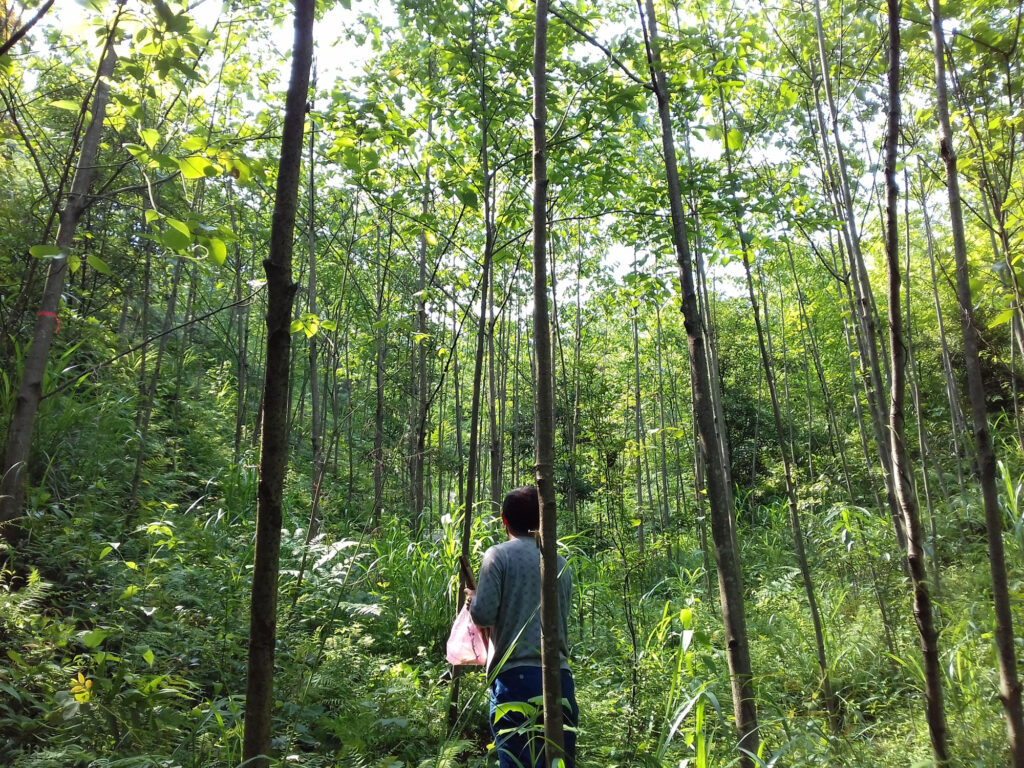Tree diversity reduces heat peaks in forests
Freiburg, 24/03/2025
The more species-rich the forest, the cooler it remains during heat waves and the warmer during cold waves, shows a new study with participation from the University of Freiburg.

Below the tree canopy, it is cooler during heat waves and warmer during cold waves than in the surrounding area. This temperature buffering is stronger the more tree species grow in the forest. The photo shows an experimental plot in the BEF-China experiment. Photo: Florian Schnabel / University of Freiburg
A forest with high tree-species diversity is better at buffering heat peaks in summer and cold peaks in winter than a forest with fewer tree species. This is the result a new study with participation from the University of Freiburg, which was published in the journal Ecology Letters. Trees have long been known to buffer temperature extremes, reducing heat peaks within forests during hot summer and reducing cold peaks during wintertime. However, it was unknown whether the number of tree species, “tree species richness”, could increase the potential of forests to buffer heat and cold peaks. To answer this question, the researchers relied on data from the largest planted tree diversity experiment worldwide, located in subtropical China. In the so-called BEF-China experiment, several hundred thousand trees were planted into plots consisting of 1, 2, 4, 8, 16, or 24 different tree species, respectively.
Cooling on experimental plots with many different tree species up to 4.4 °C stronger
The results showed that forests rich in tree species lowered temperatures below the canopy during heat peaks more than forests with fewer tree species. The effect was strongest during midday heat in summer. Cooling was up to 4.4°C stronger in experimental plots with 24 species compared to plots with just a single species. Species-rich forests were also better at increasing temperatures during cold hours at nighttime and during winter.
„With our study, we were able to demonstrate that forests can better compensate for temperature fluctuations the more different tree species they contain. This highlights the benefits of tree species diversity for large-scale reforestation initiatives and urban forests that aim to reduce heat stress in a warming world,“ explains co-first author Dr Florian Schnabel, forest scientist from the Faculty of Environment and Natural Resources, who led the research work already during his previous position at the German Centre for Integrative Biodiversity Research (iDiv) and Leipzig University and subsequently continued it at the University of Freiburg.

“Our study highlights the benefits of tree species diversity for large-scale reforestation initiatives and urban forests that aim to reduce heat stress in a warming world.”
Dr Florian Schnabel
Faculty of Environment and Natural Resources, University of Freiburg
A possible reason for the temperature-stabilizing effect: Experimental plots with many tree species had both a higher tree crown density and a higher structural diversity (for example, a greater variety of smaller and larger trees). These factors may improve temperature buffering due to reduced mixing of air masses, the researchers suspect.
Further information
- Original publication: Florian Schnabel, Rémy Beugnon, Bo Yang, Ronny Richter, Nico Eisenhauer, Yuanyuan Huang, Xiaojuan Liu, Christian Wirth, Simone Cesarz, Andreas Fichtner, Maria D. Perles-Garcia, Georg J. A. Hähn, Werner Härdtle, Matthias Kunz, Nadia C. Castro Izaguirre, Pascal A. Niklaus, Goddert von Oheimb, Bernhard Schmid, Stefan Trogisch, Manfred Wendisch, Keping Ma, Helge Bruelheide (2025). Tree diversity increases forest temperature buffering via enhancing canopy density and structural diversity. Ecological Letters.
- Dr Florian Schnabel is a forest scientist at the Faculty of Environment and Natural Resources at the University of Freiburg. His research focuses on the relationships between biodiversity and ecosystem functions of forests, sustainable forest management in the face of global change and the effects of climate extremes on forests. He is an Associate Investigator of the Future Forests Cluster of Excellence initiative.